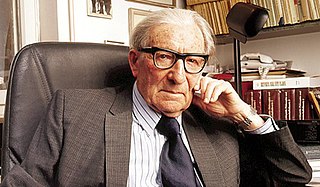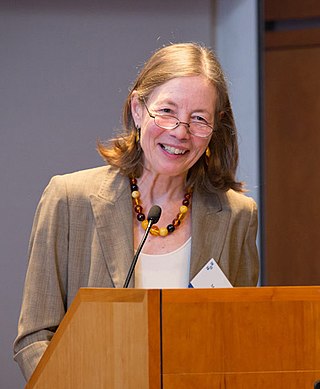Related Research Articles

Aage Niels Bohr was a Danish nuclear physicist who shared the Nobel Prize in Physics in 1975 with Ben Roy Mottelson and James Rainwater "for the discovery of the connection between collective motion and particle motion in atomic nuclei and the development of the theory of the structure of the atomic nucleus based on this connection". His father was Niels Bohr.

Abraham Pais was a Dutch-American physicist and science historian. Pais earned his Ph.D. from University of Utrecht just prior to a Nazi ban on Jewish participation in Dutch universities during World War II. When the Nazis began the forced relocation of Dutch Jews, he went into hiding, but was later arrested and saved only by the end of the war. He then served as an assistant to Niels Bohr in Denmark and was later a colleague of Albert Einstein at the Institute for Advanced Study in Princeton, New Jersey. Pais wrote books documenting the lives of these two great physicists and the contributions they and others made to modern physics. He was a physics professor at Rockefeller University until his retirement.

Virginia Louise Trimble is an American astronomer specializing in the structure and evolution of stars and galaxies, and the history of astronomy. She has published more than 600 works in Astrophysics, and dozens of other works in the history of other sciences. She is famous for an annual review of astronomy and astrophysics research that was published in the Publications of the Astronomical Society of the Pacific, and often gives summary reviews at astrophysical conferences. In 2018, she was elected a Patron of the American Astronomical Society, for her many years of intellectual, organizational, and financial contributions to the society.

John Norris Bahcall was an American astrophysicist and the Richard Black Professor for Astrophysics at the Institute for Advanced Study. He was known for a wide range of contributions to solar, galactic and extragalactic astrophysics, including the solar neutrino problem, the development of the Hubble Space Telescope and for his leadership and development of the Institute for Advanced Study in Princeton.

Roy Jay Glauber was an American theoretical physicist. He was the Mallinckrodt Professor of Physics at Harvard University and Adjunct Professor of Optical Sciences at the University of Arizona. Born in New York City, he was awarded one half of the 2005 Nobel Prize in Physics "for his contribution to the quantum theory of optical coherence", with the other half shared by John L. Hall and Theodor W. Hänsch. In this work, published in 1963, he created a model for photodetection and explained the fundamental characteristics of different types of light, such as laser light and light from light bulbs. His theories are widely used in the field of quantum optics. In statistical physics he pioneered the study of the dynamics of first-order phase transitions, since he first defined and investigated the stochastic dynamics of an Ising model in a paper published in 1963. He served on the National Advisory Board of the Center for Arms Control and Non-Proliferation, the research arms of Council for a Livable World.

Spencer R. Weart is the former director of the Center for History of Physics of the American Institute of Physics (AIP) from 1971 until his retirement in 2009.

Max Jammer, was an Israeli physicist and philosopher of physics. He was born in Berlin, Germany. He was Rector and Acting President at Bar-Ilan University from 1967 to 1977.
The Aneesur Rahman Prize for Computational Physics is a prize that has been awarded annually by the American Physical Society since 1993. The recipient is chosen for "outstanding achievement in computational physics research" and it is the highest award given by the APS for work in computational physics. The prize is named after Aneesur Rahman (1927–1987), pioneer of the molecular dynamics simulation method. The prize was valued at $5,000 from 2007 to 2014, and is currently valued at $10,000.
The Earle K. Plyler Prize for Molecular Spectroscopy and Dynamics is a prize that has been awarded annually by the American Physical Society since 1977. The recipient is chosen for "notable contributions to the field of molecular spectroscopy and dynamics". The prize is named after Earle K. Plyler, who was a leading experimenter in the field of infrared spectroscopy; as of 2007 it is valued at $10,000. The prize is currently sponsored by the AIP Journal of Chemical Physics.

Mary Jo Nye is an American historian of science and Horning Professor in the Humanities emerita of the History Department at Oregon State University. She is known for her work on the relationships between scientific discovery and social and political phenomena.

Helge Stjernholm Kragh is a Danish historian of science who focuses on the development of 19th century physics, chemistry, and astronomy. His published work includes biographies of Paul Dirac, Julius Thomsen and Ludvig Lorenz, and The Oxford Handbook of the History of Modern Cosmology (2019) which he co-edited with Malcolm Longair.

Hasok Chang is a Korean-born American historian and philosopher of science currently serving as the Hans Rausing Professor at the Department of History and Philosophy of Science at the University of Cambridge and a board member of the Philosophy of Science Association. He previously served as president of the British Society for the History of Science from 2012 to 2014.
Silvan Samuel Schweber was a French-born American theoretical physicist and historian of science.
David C. Cassidy is an American historian of science and professor emeritus at Hofstra University, Hempstead, New York. He is best known for his contributions to the history of quantum mechanics, scientific biography, history of physics in Germany and the United States and, most recently, science-history drama.
Russell Keith McCormmach, the husband of the late Christa Jungnickel, is an American historian of physics.
Lillian Hartman Hoddeson is an American historian of science, specializing in the history of physics and technology during the 2nd half of the 20th century.
Allan David Franklin is an American physicist, historian of science, and philosopher of science.

Subtle is the Lord: The Science and the Life of Albert Einstein is a biography of Albert Einstein written by Abraham Pais. First published in 1982 by Oxford University Press, the book is one of the most acclaimed biographies of the scientist. This was not the first popular biography of Einstein, but it was the first to focus on his scientific research as opposed to his life as a popular figure. Pais, renowned for his work in theoretical particle physics, was a friend of Einstein's at the Institute for Advanced Study in his early career. Originally published in English in the United States and the United Kingdom, the book has translations in over a dozen languages. Pais later released a sequel to the book in 1994 titled Einstein Lived Here and, after his death in 2000, the University Press released a posthumous reprint of the biography in 2005, with a new foreword by Roger Penrose. Considered very popular for a science book, the biography sold tens of thousands of copies of both paperback and hardcover versions in its first year. The book has received many reviews and, the year after its initial publication, it won both the 1983 National Book Award for Nonfiction, in Science (Hardcover), and the 1983 Science Writing Award.
References
- 1 2 "Abraham Pais Prize for History of Physics". www.aps.org. Retrieved 2023-10-07.